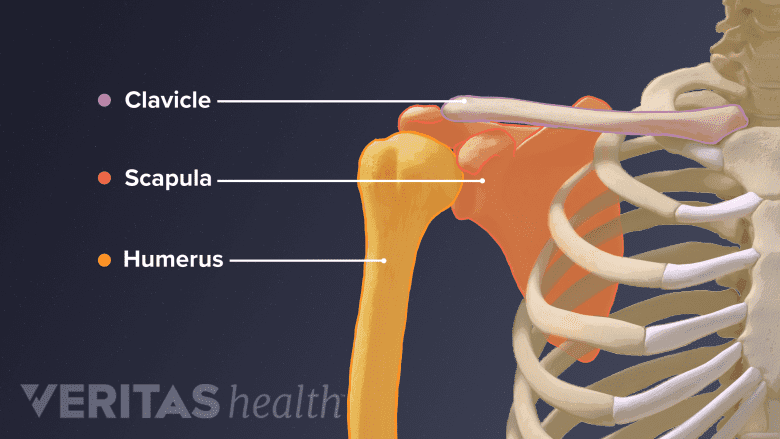Shoulder fractures involve at least one of three bones in the shoulder: the scapula (shoulder blade), clavicle (collarbone), or humerus (upper arm bone). All three types of fractures can cause shoulder pain, swelling, tenderness, and limit the shoulder’s range of motion, but there are also significant differences.

The bones of the shoulder include the clavicle (collarbone), the scapula (shoulderblade), and the humerus (upper arm bone).
1. Clavicle Fracture
The clavicle (collarbone) is a long, thin bone that begins at the base of the neck and extends out to the shoulder. Clavicle fractures can happen at any age, from newborns to the elderly.
See Clavicle Fractures: Types and Symptoms
Normally, these fractures occur because of a fall, direct hit, contact sport (such as hockey or football), or a motor vehicle accident. Bruising, swelling, and pain over the clavicle region are common symptoms. A bump may also form over the site of injury due to hematoma (swelling confined to a specific area) or deformity of the bone. When the clavicle is fractured, patients typically have difficulty raising the arm.
2. Proximal Humerus Fracture

A fracture near the humerus head is a proximal humerus fracture.
The humerus is the long bone that runs from the elbow to the shoulder. A proximal humerus fracture is a fracture to top of the humerus bone, either at or just below the humeral head. The humeral head is often referred to as the ball that rests in the shoulder’s socket.
Proximal humerus fractures are common. They can occur at any age, but the risk increases with age and osteoporosis.
There are two other types of humerus fractures. These fractures do not affect the shoulder joint as much as a proximal humerus fracture.
- A humeral shaft fracture affects the middle portion of the humerus bone.
- A distal humerus fracture affects the bottom end of the humerus, near the elbow joint.
A humeral fracture can often be treated without surgery. Factors that influence the need for surgery include the amount of displacement, involvement of the cartilage in the joint, and the age and activity level of the patient.
See Treating a Proximal Humerus Fracture
3. Scapula Fracture

A comminuted scapula fracture occurs when the scapula breaks into more than three fragments.
The scapula is a flat triangular bone located in the upper back. It provides the primary connections between the chest and the arm. Scapula fractures are rare, accounting for less than 1% of all fractures and only 3% to 5% of fractures of the shoulder.1Stannard JP, Schmidt AH, Kregor PJ. Treatment of Orthopaedic Trauma. New York: Thieme Medical Publishers; 2007. They are most commonly seen in men between 25 and 45 years of age.
See A Broken Shoulder: Scapula Fracture
A scapular fracture may result from a contact sport, such as football, or a traumatic event, such as an automobile accident. Given the impact needed for the scapula to fracture, a person with this type of injury typically has sustained other damage, such as nerve injuries, rib fractures, or lung injuries.
Displaced and Non-Displaced Fractures
Most shoulder fractures are treated successfully without surgery. Nonsurgical treatment is an option when the bones are non-displaced, which means the bones remain in their correct, anatomical positions. About 80% of shoulder fractures are non-displaced.2Shoulder Fractures. Cleveland Clinic website. http://my.clevelandclinic.org/services/orthopaedics-rheumatology/diseases-conditions/shoulder-fracture. Accessed June 2, 2016.
In contrast, a shoulder fracture is described as displaced when the pieces of broken bone are separated and no longer in their correct, anatomical position. Displaced fractures may require surgery to realign the bones so they heal in their accurate positions.
Causes of Fractures
Common causes of shoulder fractures include:
- Falling from a height, such as from a horse or when rock climbing
- Contact sports, including football
- Other traumatic events, such as motor vehicle accidents
Decreased bone mass associated with osteoporosis can increase the risk of shoulder fractures.
- 1 Stannard JP, Schmidt AH, Kregor PJ. Treatment of Orthopaedic Trauma. New York: Thieme Medical Publishers; 2007.
- 2 Shoulder Fractures. Cleveland Clinic website. http://my.clevelandclinic.org/services/orthopaedics-rheumatology/diseases-conditions/shoulder-fracture. Accessed June 2, 2016.

